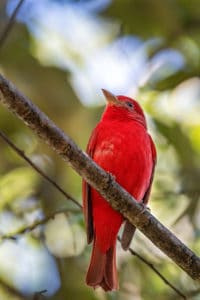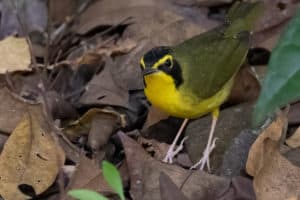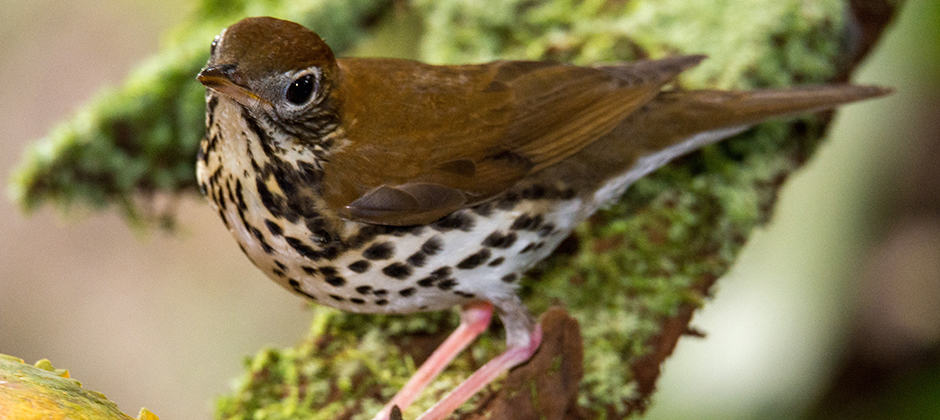Share this article
Partners in Flight sees past success, future challenges
In the 1980s, biologists Chan Robbins and John Sauer reached a startling conclusion. Studying data from the Breeding Bird Survey — a project Robbins pioneered — they found birds that migrated long distances to the United States and Canada were declining. The birds that people were accustomed to seeing in their backyards were facing threats, it appeared, on wintering grounds in Central and South America, on migration routes back and forth and, at least in some cases, on their North American nesting grounds.
“The farther they went the more they were declining,” said TWS member Geoff Geupel, strategic partnerships director with Point Blue, a California nonprofit conservation science organization. At its base at the Point Reyes Bird Observatory, Geupel saw firsthand the decline of warbling vireos (Vireo gilvus). “It was clearly a continental problem, across a full life cycle of these birds,” Geupel said.
As the public became concerned, biologists embarked on symposia to understand the issue and conservationists sought a coordinated response. Cooperative efforts had already worked together to protect waterfowl. Couldn’t the same thing be done for nonhunted species?
The result was Partners in Flight, a pioneering effort to bring together federal and state agencies, nonprofits and university researchers to address migratory bird declines that went beyond state and national borders. Formed in 1990, the partnership is celebrating its 30th anniversary this year. The occasion has partners looking back on what they’ve learned over the decades and eying the challenges ahead.
Keep common birds common
“We really wanted to keep common birds common,” said Geupel, a songbird biologist involved in Partners in Flight since its formation. Those words —“keep common birds common” — became the partnership’s motto. At the time, nongame bird conservation typically revolved around bluebird boxes and backyard feeding tips, Geupel said. Conservationists began calling for a concerted effort to take these birds as seriously as managers took hunted species and stem their decline before they became endangered.

A summer tanager (Piranga rubra), seen wintering in Guatemala. Credit: Jim Ramakka
For biologists who felt migratory birds had long been overlooked, it was a welcome change.
“I couldn’t believe it,” said TWS member Terry Rich, a Bureau of Land Management biologist working on North Dakota mineral leases at the time. “All my birding friends were like, ‘Yes! Sparrows and warblers are on the table at last!’ That was a very exciting time.”
The National Fish and Wildlife Foundation, led by its then-executive director Amos Eno, helped launch the partnership. Federal agencies, state agencies, nonprofits and universities joined in.
“Helping to facilitate this joint effort in Nevada is one of the things I’m proudest of in my career,” said TWS member Jim Ramakka, who was a BLM biologist in Nevada when he started working with Partners in Flight. Soon he found himself functioning as the chair of the state working group.
A change in management
Looking at the rest of the Western Working Group that his state was a part of, Ramakka and a few other biologists felt like Nevada was lagging behind. In a state the size of New England with ecosystems ranging from snow-capped mountains to Joshua tree-dotted deserts, Nevada biologists struggled to understand what birds nested there, and where, he said. Collaboration among working group members and BLM seed money led to the foundation of the Great Basin Bird Observatory, which coordinated a breeding bird atlas by breaking the state into square-mile blocks and trying to craft a statistically valid way to record distributions.
“We started out slowly, trying to figure out what to do and how to go about it and working on strategies,” Ramakka said. “How do you prioritize what are important species? What are important habitats? What we found out was that, while the few state agency nongame biologists might have some information specific their areas, the federal agency people lacked even basic data. Birdwatchers might know a lot, but they weren’t used to communicating with the agencies. PIF brought them all together to gather and share information and their common interests in bird conservation. Working toward a common goal, professional biologists and over 100 volunteer birdwatchers made the Nevada Breeding Bird Atlas happen. The atlas in turn served as the foundation for statewide land bird monitoring and coordinated planning.”
“It was about establishing a logical, data-driven approach to ranking species by need,” Rich said.
Soon, partners felt like they were witnessing a change in wildlife management. Hunted species weren’t the only focus anymore. In North Dakota, Rich, who served as chair of the national initiative in 2000, found managers now allowed him to include impacts to raptors and prairie birds as the agency crafted land use plans. Similar changes were happening across the country.
“The biggest accomplishments are still probably getting nongame birds as a more routine part of what agencies do when they’re planning and budgeting,” he said.
‘A trajectory towards recovery’
Over the years, the partnership created a species assessment process and database to improve data collection. It formed continental and regional conservation plans. It launched what has become World Migratory Bird Day. Participants say it has also been a catalyst for important actions — the Neotropical Migratory Bird Conservation Act, State Wildlife Grants and Action Plans to protect species of greatest conservation need, the expansion of the U.S. Fish and Wildlife Service’s Migratory Bird Program, the establishment of public-private migratory bird joint ventures and the creation of habitat conservation programs in the Farm Bill.

A Kentucky warbler (Geothlypis formosa), seen wintering in Belize. Credit: Jim Ramakka
“It got people thinking about things differently,” Geupel said, and birds benefited as a result. The recent delisting of the Kirtland’s warbler (Setophaga kirtlandii) may not be a direct result of Partners in Flight, he said, but the partnership encouraged biologists to take into account broader ecosystem management concepts, including the role of fire, which allowed the warbler to rebound.
Other birds, like bald eagles (Haliaeetus leucocephalus), peregrine falcons (Falco peregrinus) and cerulean warblers (Setophaga cerulea), have also benefited, wrote Ken Rosenberg, of the Cornell Lab of Ornithology and American Bird Conservancy, and Bob Ford, the current Partners in Flight national coordinator. “Largely due to these sea-changes in the way birds are managed, initiated and promoted by [Partners in Flight], we have seen a trajectory towards recovery of endangered species and voluntary proactive conservation as an alternative to listing.”
A ‘working anniversary’
Amid these successes came another disturbing study, though. Last year, researchers found North America’s breeding birds had declined by nearly 3 billion since 1970, raising new concerns about their future.
“The 3 billion bird loss seems like a failure,” Goepel said, but if there’s a silver lining, it’s that those losses never would have been known without the data collection and sharing Partners in Flight pioneered.
The group sees the 30-year mark as a “working anniversary,” with efforts focused on new and creative approaches for conservation. Its past successes may offer some hope for the future.
“Kirtland’s warblers, peregrines and bald eagles are pretty good stories that show if we focus all of our energy and our processes and our money and our regulations, we can have an effect,” Rich said. “We can do good things for species.”
Header Image: When biologists realized songbirds were declining, it raised concerns about threats they may face on their winter range, like this wood thrush (Hylocichla mustelina) seen in Costa Rica. Credit: Jim Ramakka








